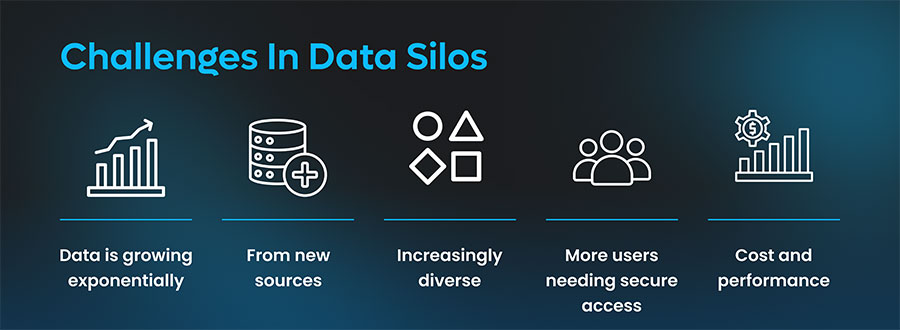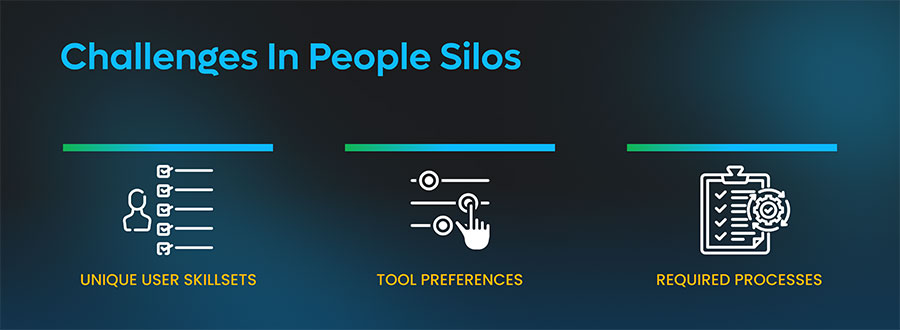Everything You Need to Know About Modern Data Management.
Businesses are usually tackling (or struggling with) unprecedented challenges and opportunities – and the latest opportunity wrapped with challenges being Data Management.
Shockingly, only 3% of businesses’ data meets basic quality standards, highlighting the urgent need for effective data management strategies.
With data breaches on the rise – averaging 536 terabytes per incident in 2021 – and poor data management practices reducing operational efficiency by 21%, the stakes have never been higher. 72% of companies recognize data as a strategic asset, driving a surge in demand for skilled data management professionals.
Despite this recognition, only 37% of businesses have a defined data management strategy, leaving them vulnerable to financial losses. Data breaches, with an average cost of $3.86 million each in 2020, emphasize the need for immediate action.
Moreover, organizations that prioritize data management can reap significant rewards, with companies experiencing an average annual revenue increase of 5.32% due to better data use. With worldwide spending on data management technologies predicted to reach $315 billion by 2024, investing in robust data strategies is essential for future success.
Why data management matters
At the heart of any successful data strategy lies effective data management. It’s the backbone that supports all other data-related initiatives, from data collection and storage to processing, analysis, and visualization.
Without proper data management practices in place, companies risk drowning in a sea of data chaos, where valuable insights are buried beneath layers of noise and inefficiency.
Data quality
Garbage in, garbage out – it’s a mantra that holds true in the world of data. Poor data quality can lead to costly errors, misleading insights, and undermined trust in decision-making processes.
Effective data management ensures that data is accurate, consistent, and reliable, providing a solid foundation for business operations and strategic initiatives.
Data accessibility
Data is only valuable if it’s accessible when and where it’s needed. Data management solutions enable organizations to break down silos, integrate disparate data sources, and provide secure access to relevant information across departments and teams..
Compliance and security
With data privacy regulations becoming increasingly stringent, companies must prioritize compliance and security in their data management practices.
Robust data governance frameworks help ensure that data is handled in accordance with regulatory requirements and industry best practices, minimizing the risk of data breaches, fines, and reputational damage.
Breaking down silos – why they’re holding your data strategy back
Imagine your business is like a bustling city, with data flowing like traffic on its streets. Now, picture silos as towering walls that divide this city into isolated neighborhoods. These silos aren’t just physical barriers; they’re also mental blocks that hinder the smooth flow of information and collaboration across your organization.

What are data silos?
These are like treasure chests buried deep within your organization. Each department or team has its own stash of valuable data, but unfortunately, it’s often inaccessible to others.
Picture your sales team holding onto customer data, while your marketing team has its own set of insights. Without a bridge connecting these silos, valuable opportunities for synergy and innovation are lost.
As your business grows and evolves, so does your data. With this exponential growth comes a whole new set of challenges that can make managing data silos feel like trying to wrangle a herd of unruly cats.

What are the drawbacks of data silos?
Data overload
Your data storage will be like a refrigerator stuffed to the brim with groceries. Every day, you’re cramming in more and more items, from fresh produce to leftovers from last night’s dinner. But eventually, you reach a point where there’s no more room, and you’re left juggling containers and hoping nothing falls out.
Similarly, the sheer volume of data pouring into your organization can quickly overwhelm your storage capacity and infrastructure, leading to bottlenecks and performance issues.
Diverse sources
Your data isn’t just coming from one faucet – it’s more like a raging river fed by countless streams and tributaries. You’ve got customer information streaming in from your website, sales data pouring in from your CRM system, social media metrics trickling in from various platforms, and the list goes on.
Each source brings its own format, structure, and quality, making it challenging to integrate and analyze effectively.
Security and access
With great data comes great responsibility – and a whole lot of headaches when it comes to keeping it safe and secure. As more users within your company get access to valuable data, ensuring that sensitive information remains protected becomes increasingly complex.
You’ve got to walk the tightrope between granting enough access to foster collaboration and innovation while also safeguarding against unauthorized access and data breaches.
Cost and performance
Managing data isn’t just a matter of flipping a switch and watching the magic happen; it requires significant investment in infrastructure, technology, and human resources. As your data grows, so do the costs associated with storing, processing, and analyzing it.
Balancing the need for high performance with budget constraints can feel like trying to juggle flaming torches while riding a unicycle – challenging, to say the least.
What are people silos?
Just as data can be locked away, so too can the expertise and knowledge of your employees. People silos occur when individuals or teams operate in isolation, hoarding their skills and insights instead of sharing them with the wider organization. This not only limits cross-functional collaboration but also stifles creativity and growth.
So, just like data silos, people silos can throw a wrench in the gears of your operation, causing friction, miscommunication, and missed opportunities.

What are the drawbacks of people silos?
Unique user skillsets
Your organization as a network of interconnected departments, each with its own valuable expertise and insights. However, when these departments operate in isolation, it’s like having different puzzle pieces that don’t quite fit together.
For example, imagine a retail company where the marketing team gathers valuable customer data through social media campaigns, but this information isn’t shared with the sales team. As a result, the sales team misses out on opportunities to tailor their approach and close more deals.
People silos hoard valuable data within certain departments; hence, insights and information will be trapped within individual departments.
User preferences
Just as everyone has their favorite flavor of ice cream, they also have their own preferences when it comes to tools, technologies, and workflows. Your marketing team might swear by their fancy analytics platform, while your sales team sticks to good old-fashioned spreadsheets.
These divergent preferences can create barriers to collaboration and hinder the adoption of standardized processes and tools across your organization.
Required processes
Every department has its own set of rituals, rites, and routines – its own secret sauce, if you will. From the way they track leads to the way they close deals, each team has honed its processes to perfection.
But when these processes are kept under lock and key, they can prevent cross-functional teams from
working together effectively. It’s like trying to solve a Rubik’s cube when all the colors are not revealed – frustrating, to say the least.
What are business silos?
These are the organizational barriers that arise when different departments or divisions operate as independent entities, rather than parts of a cohesive whole.
For example, picture your finance department making decisions without considering the impact on operations, or your marketing team launching campaigns without alignment with sales objectives.
These silos can lead to inefficiencies, conflicts, and missed opportunities for strategic alignment.

What are the drawbacks of business silos?
Unwanted cost
Ah, the almighty dollar. Business silos often arise when departments or divisions operate as independent entities, each with its own budget and bottom line.
This silo mentality can lead to redundant spending, inefficiencies, and missed opportunities for cost savings and optimization. It’s like having multiple bank accounts, each with its own stash of cash, but no centralized oversight or strategy for managing your finances.
Legacy infrastructure
Picture your organization’s IT infrastructure like a sprawling mansion – grand and impressive, but also a bit… outdated. Over the years, you’ve added new wings and extensions here and there, cobbling together a patchwork of systems and technologies.
But underneath the veneer of grandeur lies a tangled web of legacy systems and outdated processes that hinder agility and innovation. It’s like trying to navigate a maze with blindfolds on – slow, cumbersome, and prone to dead ends.
Pro tip – Modernize your IT infrastructure!
Assess your organization’s IT infrastructure and identify opportunities to modernize and streamline processes.
Whether it’s migrating to cloud-based solutions, consolidating disparate systems, or investing in automation technologies, modernizing your infrastructure can improve agility, efficiency, and scalability!
Lack of agility
Agility is the name of the game – especially nowadays. But business silos can act like anchors, weighing your organization down and impeding its ability to pivot and adapt to changing market conditions.
When departments operate in isolation, it’s like each one is steering its own ship without regard for the others, making it difficult to change course quickly or respond effectively to new opportunities or threats.
The solution? A robust and modern data management strategy, ready for future applications including AI/ML.
Extracting actionable insights from data is no easy feat. Strategically, data management serves as the mechanism to dismantle data silos, bridge the gaps between people, and address business agility while facilitating seamless migration from legacy systems. Implement a scalable, nimble, efficient and secure data strategy that ensures readiness for AI/ML applications and for the future. <<Read our data lake house architecture blog>>
Make informed decisions swiftly and confidently
A well-structured data management system ensures that decision-makers have access to accurate, timely, and relevant information.
Transform data chaos into operational excellence
Streamlined processes, reduced redundancies, data integrity, and optimized workflows are the natural outcomes of effective data management.
Adapt to changing requirements with scalability
A robust data management strategy lays the foundation for future growth by ensuring that systems can scale seamlessly to meet the organization’s expanding data needs.
Get a catalyst for cost optimization
By reducing data redundancies, eliminating inefficiencies, and ensuring optimal resource utilization, organizations can allocate resources judiciously, invest in strategic initiatives, and minimize unnecessary expenditures.
Adhere to relevant regulations
Data regulations and privacy concerns are increasing, thus making compliance non-negotiable. Effective data management practices establish a robust framework for compliance, safeguarding sensitive information and mitigating risks associated with legal and regulatory requirements.
You can adhere to relevant regulations and maintain the trust and confidence of stakeholders, by implementing data governance policies and procedures.
About PeritusHub
We specialize in crafting tailored Data Management solutions designed to address the unique needs and challenges of our clients.
Our expertise in Data Engineering and Governance empowers businesses to harness the full power of their data.
From breaking down silos to ensuring data security and compliance, we provide end-to-end support to help organizations unlock the true value of their data assets.












